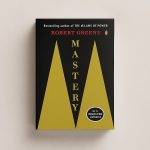Mastery by Robert Greene is a definitive guide to achieving excellence in any field. Through historical case studies, contemporary examples, and actionable strategies, Greene reveals the path from novice to intuitive expert. He outlines six transformative phases – from discovering your Life’s Task to fusing logic and intuition – that apply universally, whether in science, art, business, or personal growth. By blending rational analysis with creativity, and technical skill with social intelligence, Mastery shows that greatness is not reserved for the gifted few but achievable by anyone committed to disciplined learning, adaptability, and self-awareness. This is a roadmap to lifelong fruition.
1. Introduction to Mastery by Robert Greene
Mastery by Robert Greene is a detailed exploration of how individuals can achieve the highest level of skill, creativity, and accomplishment in their chosen fields. The book argues that mastery – the fusion of deep rational knowledge with intuitive insight – is not the domain of a select few but a process accessible to anyone willing to dedicate time, attention, and effort to their “Life’s Task.”
Greene combines historical case studies, profiles of contemporary figures, practical strategies, and psychological research to create a systematic framework for moving from novice to master. He organizes the book into six interlinked stages:
- Discover Your Life’s Task
- Submit to Reality: The Ideal Apprenticeship
- Absorb the Master’s Power: The Mentor Dynamic
- See People as They Are: Social Intelligence
- Awaken the Dimensional Mind: The Creative-Active
- Fuse the Intuitive with the Rational: Mastery
This journey is presented not as a rigid formula but as a flexible set of principles adaptable to individual circumstances, strengths, and inclinations.
2. Author Biography – Robert Greene
Robert Greene is an American author best known for works on strategy, power dynamics, and human behavior. Before becoming a full-time writer, Greene worked in over 80 jobs, from construction to Hollywood scriptwriting, experiences that shaped his observational skills and deep interest in the human condition.
Greene’s earlier bestsellers The 48 Laws of Power, The Art of Seduction, and The 33 Strategies of War – examined power structures and persuasion tactics. Mastery (2012) shifted his focus from gaining power to cultivating long-term excellence through disciplined learning and creative engagement. His signature style blends historical biography, social psychology, and practical advice, framed in clear, assertive prose that bridges storytelling with instructive guidance.
3. Core Thesis and Conceptual Framework
Greene defines mastery as the combination of:
– Deep rational understanding (gained through formal and informal learning, practice, and experience).
– Intuitive grasp of complexity (arising when knowledge is so well absorbed that actions become fluid, creative, and adaptable).
Key principles underpinning his thesis:
– Innate Inclination: Everyone has a Life’s Task (natural calling) aligned with their deepest interests and unique potential.
– Deliberate Apprenticeship: Learning is most powerful when pursued methodically under real-world conditions.
– Mentorship: Absorbing wisdom from a more experienced figure accelerates growth.
– Social Intelligence: Understanding human dynamics is critical to navigating obstacles.
– Controlled Creativity: Innovation comes from building on, and breaking, deep knowledge.
– Integration of Rational and Intuitive: The master seamlessly fuses logic with instinct.
4. Structure Breakdown and In‑Depth Synthesis
Part I – Discover Your Calling: The Life’s Task
Mastery by Robert Greene begins by emphasizing that each person has a set of primal inclinations, visible even in childhood. Masters from Leonardo da Vinci to Albert Einstein followed paths aligned with these inborn fascinations.
Key ideas:
– Suppressing your Life’s Task for money, prestige, or imitation leads to mediocrity and dissatisfaction.
– Self-discovery requires honest reflection, tracing early interests, and resisting social pressure.
Strategies:
- Return to Your Origins – Identify childhood patterns of curiosity and joy.
- Occupy the Perfect Niche – Like Darwin, adapt your position to your strengths and environment.
- Avoid the False Path – Reject careers chosen for prestige or parental approval.
- Let Go of the Past – Adapt when circumstances change radically (e.g., Freddie Roach reinventing himself from boxer to coach).
- Find Your Way Back – Even after wandering, you can re‑align with your Life’s Task.
Reversal: Some masters, like Temple Grandin, turned perceived limitations into defining strengths.
Part II – Submit to Reality: The Ideal Apprenticeship
After discovering your Life’s Task, the next phase is immersive learning, not immediate ambition.
The Apprenticeship Phase:
- Deep Observation (Passive Mode) – Learn patterns, absorb culture, understand power structures before acting.
- Skills Acquisition (Practice Mode) – Pursue deliberate practice to lock skills into memory; embrace tedium and repetition.
- Experimentation (Active Mode) – Begin testing personal approaches and innovations.
Guiding strategies:
– Value Learning over Money – Prioritize roles that offer skill growth.
– Expand Your Horizons – Explore complementary disciplines.
– Revert to Inferiority – Keep the mindset of a beginner to absorb more.
– Trust the Process – Resist the urge for premature rewards.
– Move Toward Resistance and Pain – Seek difficult challenges to accelerate growth.
– Apprentice Yourself in Failure – Treat setbacks as data.
– Combine the “How” and “What” – Integrate procedural skill with conceptual understanding.
– Advance through Trial and Error – Use iterative cycles for refinement.
Part III – Absorb the Master’s Power: The Mentor Dynamic
Greene highlights that while self-learning is vital, the presence of a mentor accelerates progress through concentrated feedback, encouragement, and challenge.
Mentorship benefits:
– Compresses learning time.
– Provides model behavior for discipline and thinking.
– Offers insider perspectives and corrections unavailable through books alone.
Strategies for successful mentorship:
- Choose mentors aligned with your needs and ambitions.
- Gaze Deep into the Mentor’s Mirror – Learn self-awareness through their feedback.
- Transfigure Their Ideas – Adapt their teachings to your own vision.
- Create a Back-and-Forth Dynamic – Evolve from recipient to collaborator.
Reversal: Eventually, you must surpass your mentor, shedding dependence to avoid stagnation.
Part IV – See People As They Are: Social Intelligence
Technical skill alone is insufficient; interpersonal skills determine whether your work sees the light of day.
Two main dimensions:
- Specific Knowledge – Reading nonverbal cues, tone, and microexpressions.
- General Knowledge – Recognizing the “Seven Deadly Realities” of human nature: Envy, Conformism, Rigidity, Self‑Obsessiveness, Laziness, Flightiness, Passive Aggression.
Strategies:
– Speak through your work – let excellence be your strongest argument.
– Craft the appropriate persona for each context without losing authenticity.
– See yourself from others’ perspectives to manage impressions.
– Suffer fools gladly – avoid needless confrontations that waste energy.
Part V – Awaken the Dimensional Mind: The Creative-Active
After mastering fundamentals, you must avoid creative stagnation by expanding beyond your comfort zone.
The Creative-Active approach:
– Cultivate Negative Capability – Tolerate ambiguity without rushing to closure.
– Allow for Serendipity – Expose yourself to chance encounters and ideas.
– Alternate Mental States (“The Current”) – Shift between hard focus and relaxed, intuitive states.
– Alter Perspective – Change vantage points:
– Focus on what instead of how.
– Switch between macro and micro views.
– Seek anomalies.
– Consider what is absent.
– Revert to Primal Intelligence – Think in images, diagrams, and models.
Creative Breakthrough: Often arrives after a period of intense struggle, tension, and release – a dynamic observed in figures from Einstein to Wagner.
Avoid Emotional Pitfalls: Complacency, conservatism, dependency, impatience, grandiosity, inflexibility.
Part VI – Fuse the Intuitive with the Rational: Mastery
At the final stage, your accumulated experience becomes second nature. Decision-making feels fluid; the boundary between conscious planning and instinct dissolves.
Roots of Masterly Intuition:
– Repeated deep engagement creates memory patterns and unconscious recognition systems (similar to a chess master’s intuition).
– Tolerance for complexity and ambiguity allows rapid synthesis.
Strategies:
- Connect to Your Environment – Use all senses to read subtle cues.
- Play to Your Strengths – Focus where expertise and natural ability intersect.
- Transform Yourself Through Practice – Develop “fingertip feel” through relentless application.
- Internalize Details – Achieve complete fluency so that execution is effortless.
- Widen Your Vision – Maintain global awareness of trends and opportunities.
- Submit to the Other – Learn to inhabit others’ perspectives fully.
- Synthesize Knowledge – Integrate insights from multiple fields; become a Universal Man/Woman.
5. Thematic Patterns Across the Book
– Resilience over Genius: Mastery emerges more from years of dedication than from innate brilliance.
– Constructive Struggle: Periods of difficulty are productive, laying the groundwork for breakthroughs.
– Adaptive Strategy: The path to mastery is individualized – strategies are tools, not dogma.
– Human Dynamics: Success rests on relationships as much as on technical competence.
– Creativity as Reconstruction: Innovation builds upon deep internalization of foundational patterns.
– Integration: Rational analysis and intuitive leaps are complementary, not opposites.
6. Integration with Contemporary Context
Mastery by Robert Greene ’s model finds applications in:
– Career Development: Encouraging delayed optimization to ensure domain-person fit.
– Entrepreneurship: Using diverse experiences and mentorship to navigate uncertainty.
– Creative Industries: Breaking conventions from a position of mastery.
– STEM Fields: Leveraging interdisciplinary learning to spark research innovation.
– Personal Growth: Applying apprenticeship and feedback loops to self-improvement efforts.
In an age of rapid technological and social change, the ability to continually re-apprentice, absorb new frameworks, and integrate them is itself a form of mastery.
7. Critiques and Counterpoints
– Breadth vs. Depth: Greene stresses prolonged focus in one domain, which may seem at odds with emerging research favoring breadth in early career stages (cf. David Epstein’s Range). However, Greene’s model can integrate breadth during apprenticeship before deep specialization.
– Historical Bias: The book’s illustrative figures often come from Western history, with less emphasis on non-Western traditions of mastery.
– Idealization of the Past: Mentorship and traditional apprenticeships are harder to replicate in modern gig economies; more guidance on adapting to such conditions could strengthen applicability.
8. Enduring Value
Mastery by Robert Greene remains relevant because it addresses universal principles of learning, adaptability, and creativity. Its layered structure – blending inspiration from exemplars with concrete, actionable steps – makes it useful to aspiring artists, scientists, executives, and anyone seeking to rise above mediocrity.
Perhaps its greatest gift is reframing mastery not as an unattainable mystique but as the natural culmination of human learning when pursued with persistence, curiosity, and strategic self-awareness.
9. Conclusion: Mastery by Robert Greene
Robert Greene’s Mastery is both a practical manual for skill acquisition and a treatise on human potential. It demystifies the process through which icons of innovation and achievement reached their summits, revealing patterns that transcend profession, era, or culture.
The core message:
Mastery by Robert Greene is within reach. By aligning with your deepest inclinations, committing fully to learning, seeking wise guidance, understanding human nature, expanding creative capacities, and finally integrating intuition with rationality, you can achieve a level of performance that is both impactful and personally fulfilling.
In Greene’s lens, mastery is not merely professional excellence – it is a way of engaging with life as an art form.
If you found this summary helpful, please share it or leave a comment below.












